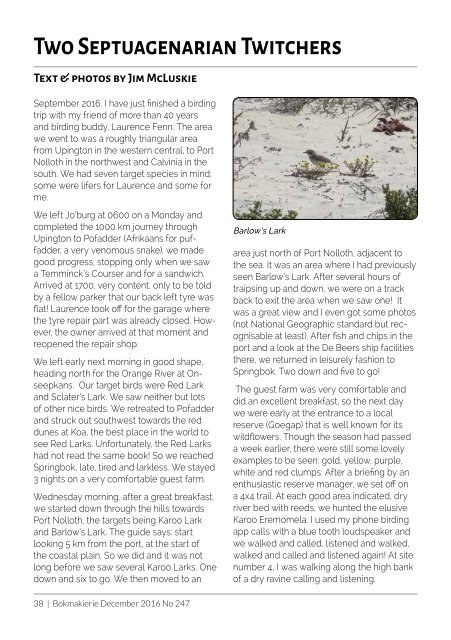Bokmakierie
AXQOBd
AXQOBd
You also want an ePaper? Increase the reach of your titles
YUMPU automatically turns print PDFs into web optimized ePapers that Google loves.
Two Septuagenarian Twitchers<br />
Text & photos by Jim McLuskie<br />
September 2016. I have just finished a birding<br />
trip with my friend of more than 40 years<br />
and birding buddy, Laurence Fenn. The area<br />
we went to was a roughly triangular area<br />
from Upington in the western central, to Port<br />
Nolloth in the northwest and Calvinia in the<br />
south. We had seven target species in mind;<br />
some were lifers for Laurence and some for<br />
me.<br />
We left Jo’burg at 0600 on a Monday and<br />
completed the 1000 km journey through<br />
Upington to Pofadder (Afrikaans for puffadder,<br />
a very venomous snake), we made<br />
good progress, stopping only when we saw<br />
a Temminck’s Courser and for a sandwich.<br />
Arrived at 1700, very content, only to be told<br />
by a fellow parker that our back left tyre was<br />
flat! Laurence took off for the garage where<br />
the tyre repair part was already closed. However,<br />
the owner arrived at that moment and<br />
reopened the repair shop.<br />
We left early next morning in good shape,<br />
heading north for the Orange River at Onseepkans.<br />
Our target birds were Red Lark<br />
and Sclater’s Lark. We saw neither but lots<br />
of other nice birds. We retreated to Pofadder<br />
and struck out southwest towards the red<br />
dunes at Koa, the best place in the world to<br />
see Red Larks. Unfortunately, the Red Larks<br />
had not read the same book! So we reached<br />
Springbok, late, tired and larkless. We stayed<br />
3 nights on a very comfortable guest farm.<br />
Wednesday morning, after a great breakfast,<br />
we started down through the hills towards<br />
Port Nolloth, the targets being Karoo Lark<br />
and Barlow’s Lark. The guide says: start<br />
looking 5 km from the port, at the start of<br />
the coastal plain. So we did and it was not<br />
long before we saw several Karoo Larks. One<br />
down and six to go. We then moved to an<br />
Barlow’s Lark<br />
area just north of Port Nolloth, adjacent to<br />
the sea. It was an area where I had previously<br />
seen Barlow’s Lark. After several hours of<br />
traipsing up and down, we were on a track<br />
back to exit the area when we saw one! It<br />
was a great view and I even got some photos<br />
(not National Geographic standard but recognisable<br />
at least). After fish and chips in the<br />
port and a look at the De Beers ship facilities<br />
there, we returned in leisurely fashion to<br />
Springbok. Two down and five to go!<br />
The guest farm was very comfortable and<br />
did an excellent breakfast, so the next day<br />
we were early at the entrance to a local<br />
reserve (Goegap) that is well known for its<br />
wildflowers. Though the season had passed<br />
a week earlier, there were still some lovely<br />
examples to be seen: gold, yellow, purple,<br />
white and red clumps. After a briefing by an<br />
enthusiastic reserve manager, we set off on<br />
a 4x4 trail. At each good area indicated, dry<br />
river bed with reeds, we hunted the elusive<br />
Karoo Eremomela. I used my phone birding<br />
app calls with a blue tooth loudspeaker and<br />
we walked and called, listened and walked,<br />
walked and called and listened again! At site<br />
number 4, I was walking along the high bank<br />
of a dry ravine calling and listening.<br />
38 | <strong>Bokmakierie</strong> December 2016 No 247


